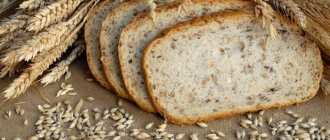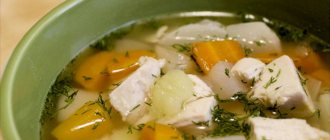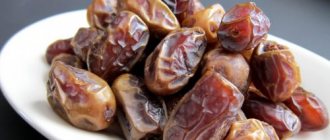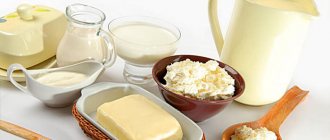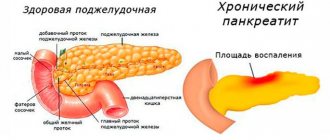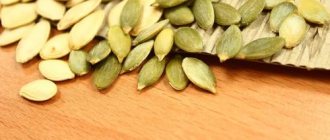In this article we will look at what you can eat if you have pancreatitis. A list of products will be presented.
Pancreatitis of the pancreas is a fairly common pathology.
A distinctive feature of this disease is acute stomach pain and a defect in the quality functioning of the organ.
A therapeutic diet for illness does not require much variety in dishes and products. In this regard, patients often ask whether cheese is allowed for pancreatitis.
This question cannot be answered unambiguously; in most cases it depends on the individual characteristics of the organism, as well as the variety and quality of the product.
Useful properties of cheese
Cheeses are high in fat, lactose and easily digestible protein. It also contains a large amount of calcium, which preserves bone structure and helps tissue renew itself. Curd products perfectly satiate and satisfy hunger, and promote accelerated digestion of food. The products can be eaten in their pure form, or added to salads, casseroles and pasta.
Tissue healing of the pancreas affected by pancreatitis is almost impossible without tryptophan, lysine, methionine, which are contained in large quantities in cheese. Among other things, phosphatides, which are found in animal fat, take part in most metabolic processes and accelerate the recovery of the pancreas. That is why some specialists allow patients to introduce a small amount of cheese into their diet for pancreatitis.
Cheese products for acute illness
At the stage of exacerbation of chronic prostatitis and at any time during the acute process of inflammation, it is dangerous to eat cheese. Nutrition during this period should be especially gentle, avoiding excessive stress on the digestive tract and pancreas.
Cheese can thus become a very heavy food that will worsen the patient's condition or cause a painful and prolonged relapse of the disease.
Many people are interested in what kind of cheese can be used for pancreatitis.
What to give up
Why can’t you eat an unlimited amount of cheese, and some varieties have to be excluded from the list of permitted ones? Harmful to the pancreas:
- Receive harmful processed and low-quality vegetable fats from your diet. Ini is found in so-called cheese products. Therefore, you need to carefully read the labels with the composition, and if there are none, refuse to purchase.
- Often, to improve the taste of low-quality cheese, manufacturers try to introduce flavoring additives, dyes and other artificial substances that negatively affect the functioning of the pancreas.
- Fatty cheeses will have to be excluded from the diet; up to 30% fat is allowed, but it’s better to start with 10%.
- Hard varieties have too coarse a structure and do not fall under the rule of obtaining gentle, crushed and soft food.
- Freshness is important. Spoiled product is often displayed on shelves with the edges cut off. The piece should be carefully inspected. There should be no damage, discoloration, irregularities in structure, and especially mold. When purchasing packaged goods, you should check the safety of the plastic or film, look at the expiration date, and make sure that the storage conditions are correct.
In addition, the production technology of some cheeses involves the presence of components that are unacceptable for an organism with a diseased pancreas. These include:
- Cheeses with mold, which enhances the functioning of the digestive tract and the secretion of pancreatic juice;
- Melted with a large amount of harmful substances, including salts. In addition, they contain the most dyes and aromatic additives that irritate the mucous membranes.
- Smoked products are generally contraindicated, and cheeses of these varieties are prohibited products.
- Cheeses with various types of additives often contain not only natural herbs, but also flavors and dyes. In addition, some additives are also prohibited products.
These cheeses should not only not lie on the table as an independent dish, but also be included in soups or salads, main courses, despite the seemingly small amount of their inclusion. The harm can be serious, including exacerbation and complications.
Cheese products for chronic pancreatitis
Curd products can be consumed in chronic pancreatitis only if the patient has achieved a state of stable remission. The first portion is allowed to be introduced into the diet only a month after the end of the attack of the disease.
Even if there are no symptoms of pancreatitis, an increased content of animal products in the diet can cause a repeated attack of inflammation and cause an exacerbation.
So, the maximum amount of cheese that is allowed to be eaten during the day is one hundred to two hundred grams (depending on the type of product). It would be better if it was homemade hard cheese. In this case, it is best to choose cheese with low density and fat content.
Cheeses that can be eaten by people suffering from gastritis
Patients who have inflamed gastric mucosa are advised to prefer non-acidic, non-pepper and non-salty foods when choosing food for consumption. Several popular varieties of cheese meet these requirements: hard, soft, blue, etc. If the product is prepared without the use of smoking technology and has a slightly fresh taste, then hard cheeses are allowed for consumption regardless of the acidity of gastritis. But it is better to eat them in ground form and in small portions.
Blue (blue) cheeses also work well for gastritis. This variety brings benefits to the patient because it contains bacteria that improve digestive processes. In addition, products with blue mold provide an “enveloping” effect and increase the protection of the mucous membranes of the stomach. However, it is important to observe moderation by limiting yourself in the amount of cheese you consume. In this case, you need to purchase only a high-quality product from reliable sellers, which is especially important for patients whose stomach is affected by gastritis. It is also important to familiarize yourself with its labeling for possible expiredness. Considering the rather high cost of the product, in many stores it sits on display longer than expected.
Soft cheeses, the most famous varieties of which are Mascarpone, Mozzarella and Ricotta, are comparable to curd mass in terms of consistency and composition. Considering that the preparation of these products is carried out without the use of spices, smoking and full aging, they are quite relevant for the diet of a person with an unhealthy stomach.
Many patients with gastritis are also interested in eating cheesecakes. This dish is allowed to be consumed quite rarely only if non-acidic cottage cheese was used in its preparation.
Processed cheese
Is it possible to eat processed cheese if you have pancreatitis?
This type differs from a number of other cheese varieties in that it is almost entirely absorbed by a healthy body. However, despite this, it is undesirable to use it for pancreatitis of any form or type.
This is due to the fact that most types of product are prepared with a large number of chemical additives, flavors, dyes and salts that are harmful to the digestive organs. Cheese often contains fillers that are dangerous for patients with pancreatitis. Because of this, processed cheese cannot be safe for the body if you are ill.
Dutch cheese
The production of the Dutch variety is made using a more complex technology, has a long aging period, and therefore can be dangerous for the pancreas in case of pancreatitis. However, it can be consumed in strictly limited quantities.
At the same time, if you melt cheese through temperature, a person can remove excess fat that is released on the surface. Meanwhile, it is necessary to monitor the patient’s condition to avoid relapse. Even a small amount of Dutch cheese can be introduced into the diet only if the disease is in stable remission.
Features of the consumption of dairy products at different stages of the disease
Depending on the characteristics of the disease, patients' diet should be adjusted. Most products that are allowed during the remission stage can cause significant harm to health during an exacerbation.
Acute phase of pancreatitis
With the first appearance of an attack of pancreatitis, you must immediately exclude all dairy products from your diet. Only from 2-3 days can you introduce milk porridge in liquid form into the menu. It should be prepared with milk 1 or 2.5% fat or diluted with water in proportions 1 to 1.
A week after an exacerbation, you can eat a small amount of low-fat cottage cheese. Product intake starts at 50 g. After a week, the daily norm is 100 grams. You can cook a steam omelet with diluted milk.
If positive dynamics are observed, then kefir can be introduced into the diet. It should be consumed gradually, also starting with 50 grams on the first day. You can increase the amount of kefir consumed to 100 grams in a week.
You can add a small amount of butter (butter or vegetable oil up to 5 grams per day) to vegetable or fruit purees. If a person has pancreatitis, then he should adhere to this diet until remission is achieved. This takes approximately 2 months.
Chronic phase of pancreatitis
A few months after the exacerbation of this disease, with the onset of a stable phase of remission, the menu of people with inflammation becomes more extensive.
Fermented milk products have a beneficial effect on the damaged pancreas, gastrointestinal tract and the body as a whole. Milk is also used only in diluted form for the preparation of:
- Jelly, omelettes;
- Porridge and first courses.
The daily consumption of butter increases to ten grams. Cottage cheese and kefir are retained in the diet, but with a small percentage of fat content. Kefir can be replaced with another dairy product, but you need to ensure that their fat content does not exceed 2.5%.
As symptoms subside, foods such as:
- Ryazhenka;
- Yogurts. Most patients are interested in the question: is it possible to consume yogurt for pancreatitis, and in what form? You can drink yogurt, but not more than one glass per day. Additionally, it is also important to consider what additives it contains.
After the permission of the attending physician, dairy drinks with sweeteners such as:
- Sweetener;
- Honey;
- Puree made from berries and fruits.
The menu also includes products such as cream and sour cream, but their fat content should not exceed 10%. It is important to note that they can be consumed no more than every other day and no more than one tablespoon.
Pancreatitis and cholecystitis
The diet consists of following certain recommendations and rules. It is necessary to eat properly in accordance with the intake and amount of food consumed. Let's look at them:
- You can consume no more than 200 grams of food at a time. Excessive food load can lead to overload of diseased organs, as well as cause a severe attack of pain;
- Steaks, pizza, and sushi should absolutely not be consumed even during the period of remission;
- It is very important that the temperature of the food consumed is not higher than 40 degrees. In addition, cold food is also not allowed to be consumed;
- It is important to consider the calorie content and the ratio of fats, carbohydrates, and proteins in the food consumed. The food consumed must be balanced in all these parameters.
Adyghe cheese for pancreatitis
This type of cheese has a low fat content, as well as valuable dietary properties. But some manufacturers put a lot of salt in the product, and because of this it can become potentially dangerous to the pancreas.
In other situations, Adyghe cheese can be consumed during a therapeutic diet against the background of pancreatitis in quantities of up to two hundred grams per day. Even with chronic pancreatitis, Adyghe cheese helps normalize digestion, strengthens tissues and improves the condition of intestinal microflora.
Which varieties are not recommended for consumption?
Treatment of chronic pancreatic diseases requires diet. On days of exacerbation, it is better to refrain from the following types of fermented milk products:
- Processed varieties of cheese. The preparation method involves distinctive features, which results in an increase in the concentration of cholesterol in the product and the concentration of carbohydrate compounds. The easy absorption of the product is due to the high content of citric acid, which is strictly contraindicated for diseases of the digestive tract. Processed cheese from most manufacturers contains flavorings, dyes, and flavor enhancers. Such substances bring undoubted harm during inflammation in the digestive system.
- Smoked varieties are unacceptable for use for pancreatitis. They contain an increased amount of table salt and food additives.
- Exotic varieties with the addition of nuts or mold or other components are strictly prohibited for use by patients with pancreatic pathology.
Low-fat varieties
By low-fat we mean those types of cheese in which the percentage concentration of lipids will not exceed ten percent. These include:
- gouda (or gaudette);
- mozzarella cheese is ideal for pancreatitis;
- bean curd (tofu, cannot melt);
- ricotta;
- Greek;
- chechil;
- sheep and goat.
These varieties are well absorbed by the body and reduce the load on the digestive system. In addition, they contain many amino acids, they are low in calories, and therefore are recommended for fasting and dietary nutrition.
How to choose cheese for pancreatitis?
Rules for choosing cheese
Even cheese allowed in the diet can irreparably harm the digestive system and the body if it is chosen incorrectly. For example, you need to pay attention to the following product properties:
- hardness;
- date of packaging and production (the fresher the cheese, the better);
- main ingredients in the composition;
- fat percentage;
- manufacturing process;
- presence of fillers.
High-quality cheese should not contain flavoring and aromatic additives, vegetable fats, artificial preservatives and dyes.
You cannot purchase a product with damaged packaging even when the expiration date expires. Homemade hard cheese is suitable in any case.
The cheese should not contain nuts, herbs or seasonings. Such products can be not only harmful, but also dangerous, both for a sick person and for a healthy one.
Permitted and prohibited varieties
In case of a pathological condition, it is advisable to eat the following types:
- semi-solid (for example, Russian);
- unsalted soft with low fat content.
Low-fat varieties are recommended when a chronic disease is in remission. These include:
- Adyghe;
- Mozzarella;
- Feta;
- Adyghe;
- Chechil;
- Burata;
- Tofu;
- Ricotta;
- Brynza;
- Suluguni.
Prohibited:
- durum varieties (they usually have a high fat content);
- including mold;
- containing additives in the form of greens or nuts;
- sausage cheese;
- processed cheeses.
It must be remembered that any type of cheese is strictly contraindicated during an acute state of pancreatitis.
- Consumption of durum varieties
- Among the solid types most often purchased:
- Dutch;
- Cheddar;
- Swiss.
Hard cheese is a product with a high fat content, so if pathology develops, it cannot be included in the menu.
The product must be stored in the refrigerator. Eating cheese that has expired is strictly prohibited. Storage recommendations should be followed to avoid premature spoilage and drying out.
What can you eat with pancreatitis: list of products
Foods that a patient is allowed to consume with pancreatitis:
- finely chopped boiled meat (rabbit, chicken, veal), souffle, steamed cutlets;
- boiled or steamed fish;
- milk: curdled milk, fermented baked milk and kefir no more than 1-5%;
- cereals: oatmeal, semolina, rice, buckwheat;
- soft-boiled eggs, but eating is allowed in small quantities;
- steamed or baked vegetables;
- baked fruits or in compotes;
- dried white bread only in small quantities;
- from sweets: marshmallows and jelly;
- drinks: decoctions, clean water, tea.
What foods are prohibited in the diet against the background of pancreatitis of the pancreas?
Here is the main list:
- fish and meat of fatty varieties;
- salty;
- drinks and sweets (except those in the list of permitted);
- roast;
- alcohol;
- smoked;
- raw vegetables and fruits;
- flour (in addition to those mentioned above);
- omelette and hard-boiled eggs;
- preservatives;
- dairy products: milk, sour cream and cottage cheese (any fatty products).
Dietary rules for pancreatitis must be followed carefully. No deviations from the described menu.
In the chronic form, the diet includes vegetables that do not cause increased production of gastric juice. That is why, if changes are made to the proposed menu, the disease will resume with renewed vigor.
The diet during exacerbation of pancreatitis of the pancreas becomes even more strict. You should try to eat as many cereals and light soups as possible. The patient needs to exclude a possible inflammatory process in the stomach. Thus, the activity of the organ is facilitated with the help of a specially designed “light” diet.
Below is a sample menu for pancreatitis of the pancreas.
